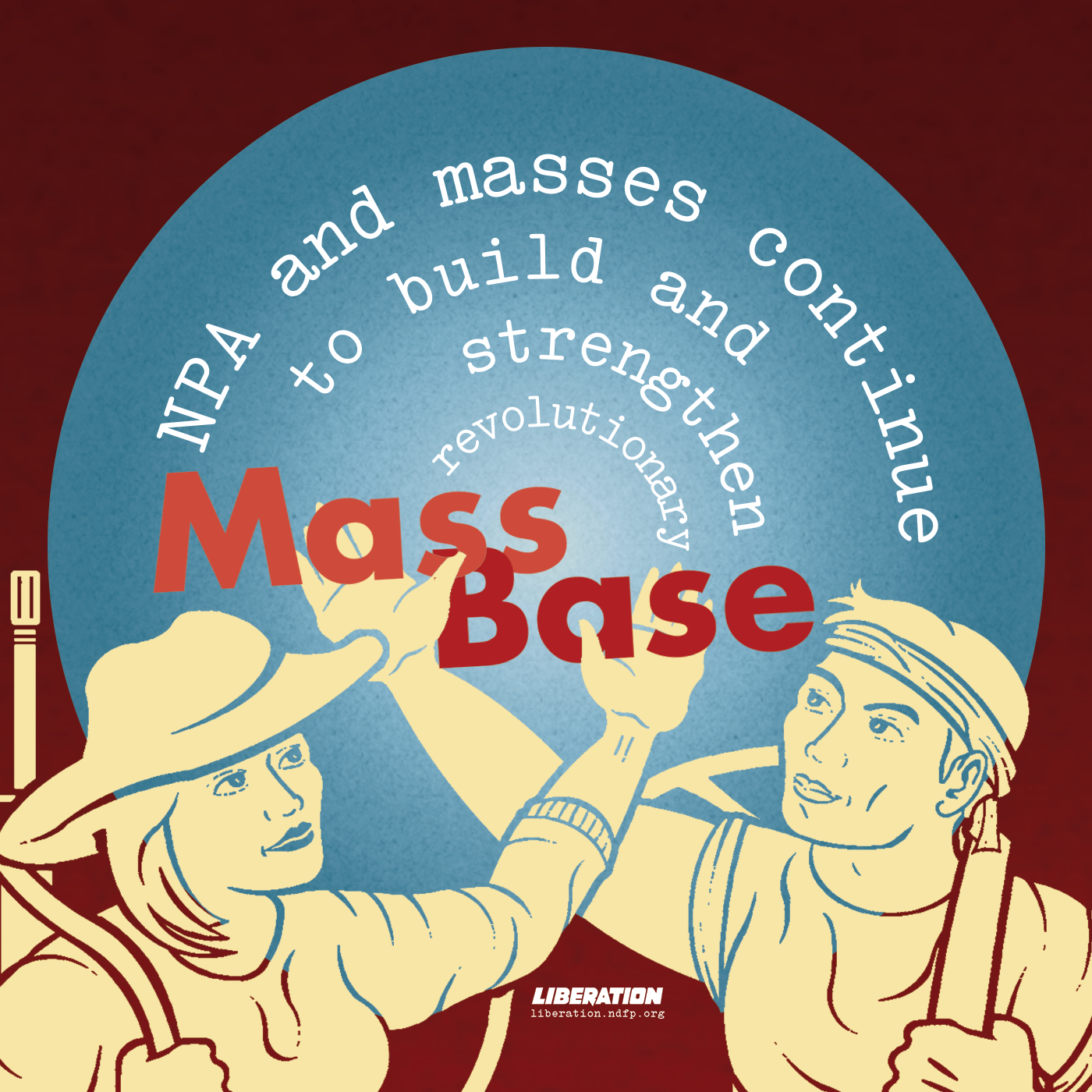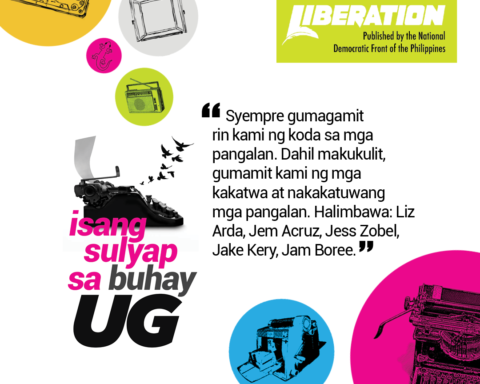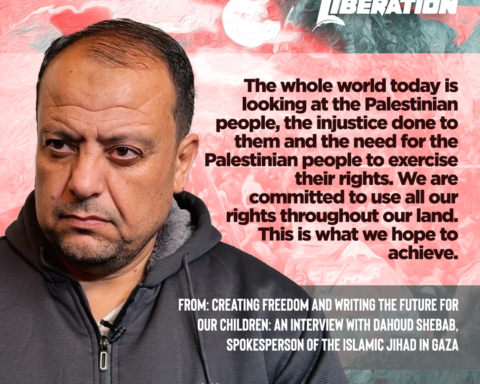The new national democratic revolution has been going on for over half a century. It has been targeted by tyrants who attempted to crush it through billions of arms procured from US imperialist and with no small amount of lies and vilification.
Bombs, cannons, and drones however “hi-tech” these are—for as long as they are used by the reactionary army against the masses and the people’s army—can neither shock nor awe the people’s will to fight for a better society, defend the victories, and make their aspiration become a reality for the whole country.
To borrow and tweak the lyrics of an old song: The hills are alive with songs of revolution. It is the sound of empowered voices of the masses and the New People’s Army (NPA) resolutely craving revolutionary change.
The #hashtag di matalo-talo (undeafeatable) referring to the Philippine revolutionary movement is an apt slogan because even during the pandemic, and despite intensified military operations of the Armed Forces of the Philippines and Philippine National Police (AFP-PNP), the red fighters of the NPA and the masses successfully implemented health measures to protect the guerrilla bases from Covid-19 and ensured a steady food supply for every household.
Under the guidance of the Communist Party of the Philippines, the NPA is tasked not only to engage in armed struggle but also to conduct agrarian revolution and to continuously build, consolidate, and expand the mass base of the revolutionary forces in the countryside. These are three-pronged tasks that complement each other and guarantee the victory of the people’s war.
Amid the pandemic and intensified focused military operations against the revolutionary and democratic forces, the people’s army carried out these tasks. Notably, those who persisted where in regions and provinces considered as priority areas of the regime’s “counterinsurgency” program. To these guerrilla fronts the reactionary government deployed the most number of battalions of the AFP and PNP.
Considering all obstacles, revolutionary work in the countryside continued. Contrary to military claims that the revolutionary NPA has weakened, it continues to operate in 110 guerrilla fronts all over the country. Here are some of the activities carried out by the people’s army, the revolutionary mass organizations, the organs of political power in the guerrilla zones as collated from articles of Ang Bayan, the official publication of the CPP.
Expansion and recovery work
Currently, some 22 battalions are deployed in Southern Luzon—a combination of forces from the AFP, PNP and its paramilitary group Citizen Armed Forces Geographical Unit (CAFGU). If the NPA had already been defeated, why are there 22 enemy battalions in Southern Tagalog (ST) region, asked Patnubay de Guia, regional spokesperson of the National Democratic Front of the Philippines.
Still, recovery of areas with previous revolutionary work was conducted. The region was cited by the CPP Central Committee in 2020 as among those who had “outstanding” experience in the expansion of the guerrilla mass base. One of these areas was in Maro which used to be the “wellspring of members of revolutionary mass organizations, as well as Red fighters and commanders.”
For almost 10 years, Maro bore the heavy presence of paramilitary and vigilante groups of the AFP. The people’s unity, built through years of revolutionary work, was overwhelmed by military terror. A CAFGU detachment and vigilante groups in the area were set-up. As a result the NPA units in the area were forced to temporarily pull out and stayed in the periphery.
But with the help of the masses, the NPA returned to Maro in 2020. Holding on to the revolutionary tradition of the area, they reached out to the masses who warmly welcomed them and told them of their continuing hardships—primarily, the same landlessness and unequal sharing scheme with the landlords.
The Fortunato Camus Command of the NPA in Cagayan Valley also has this experience. In a statement, its political officer, Elias Almazan, declared the enemy forces’ failure to “foil the expansion and consolidation of the revolutionary mass base in the region” even as battalion- and brigade-sized military operations were launched against the red fighters in the region. He commended the people’s army for the expansion and recovery of territories in barrios and towns resulting in the increase of mass base by several thousands in 2020. Also, NPA platoons were able to touch base with residents in the plains, near highways, and in coastal areas. Meanwhile, smaller NPA units were deployed in villages where there are military operations to reach out to the masses and strengthen the mass base.
“It is to the advantage of the people’s army that revolutionary ideas have for decades been sown and taken root among the masses. Its territories are expanding and more and more revolutionary mass organizations and organs of political power are established in villages and clusters of barrios,” said Almazan.
https://liberation.ndfp.info/main-stream/an-empowered-peasantry/
https://liberation.ndfp.info/main-stream/breaking-away-from-the-usurious-farm-traders/
Education and training, conferences
In April 2021, a guerrilla front in Samar successfully concluded the study of the Basic Party Course among farmers in a barrio. The course is required of new recruits to the Party.
It also held Level-2 medical training among 10 medical staff of the NPA. Some 28 residents joined the discussion as part of their consolidation activities. (Level-2 or the intermediate course on health is part of the three-tiered health training of the NPA jointly developed with the members of MASAPA, an allied organization of the NDFP, whose members are doctors, nurses and health workers, and medical students. Included in Level-2 course are the “study of anatomy, child birthing, herbal medicine production, and special procedures that include tooth extraction, simple surgery, trauma and mental health care. A number of communities now produce their own capsules and ointments from plants and herbs.”
Also in Samar, 50 members of the people’s militia finished the basic political-military training. They were representatives from five barrios in a guerrilla zone and 32 new regular members of the NPA. The revolutionary youth organization Kabataan Makabayan provided the technical and logistical support for the training. According to the trainers, the number of people’s militia who joined was an indication of the people’s determination to advance the people’s war. Many of the trainees showed potentials to be military cadres. The training was part of the overall plan of the NPA regional command to intensify guerrilla warfare and conduct more tactical offensives against state forces that continue to batter the region in its “counterinsurgency” operations.
A year ago, in June 2020, some 40 members of the revolutionary youth organization Kabataang Makabayan (KM) from various communities, towns, and cities in Bukidnon province held a conference in one of the guerrilla zones in the province. The KM members discussed the role of the youth in the issues affecting the country, including the Covid-19 pandemic. The immediate need to reach out to unorganized youth and draw them in to respond to the needs brought about by the pandemic and the regime’s sustained attacks against the people were among the actions put forward by the conference. The conference happened when there were at least four AFP battalions deployed in the province.
Cultural activities
Cultural activities and celebrations have always figured significantly in revolutionary life in the countryside. Founding anniversaries, weddings, end of trainings and conferences, were among the most celebrated events.
The celebration of the 48th founding anniversary of the NDFP in April 24, took different forms. In Northern Samar, the peasant masses and the people’s army in Northern Samar held an activity to commemorate the NDFP’s event in the face of intense military operations that have been going on for six months already.
Led by the PKM, the revolutionary organization of peasants, residents of six barrios and their allies used the occasion to strengthen their unity against the onslaught of military offensives. They pledged anew their commitment to the revolution as the only solution to the day-to-day dire situation they live in. Also, during the program, policies of the revolutionary government in the villages were explained and reiterated.
Love could move mountains, as the saying goes. Even the presence of four AFP battalions could “not deter the couples’ long-time dream of walking under the ‘arms gate,’ the customary passage of wedded couples under crossed rifles,” said a red commander.
In June 2020, some 200 villagers from different communities witnessed the wedding ceremony of several couples held somewhere in Bukidnon province. The wedding was officiated by members of the local revolutionary government; and, as in any community endeavor in guerrilla fronts, the village folk and members of the revolutionary mass organizations, prepared the food, the stage, and cultural numbers. The members of the red army performed a dance number.
Before the flag of the CPP, the couples pledged their commitment to love each other, “a love that was forged in the middle of the people’s war,” said the article. “Marriage in the revolution encompasses not only the romantic love towards a comrade, but also the genuine love and service to the masses.”
Indeed, love and service to the people and the burning desire for a better tomorrow move mountains better than tyranny and terror. That’s the way things go in the guerrilla zones where people’s revolutionary organizations and organs of political power continue to multiply and advance. ###






